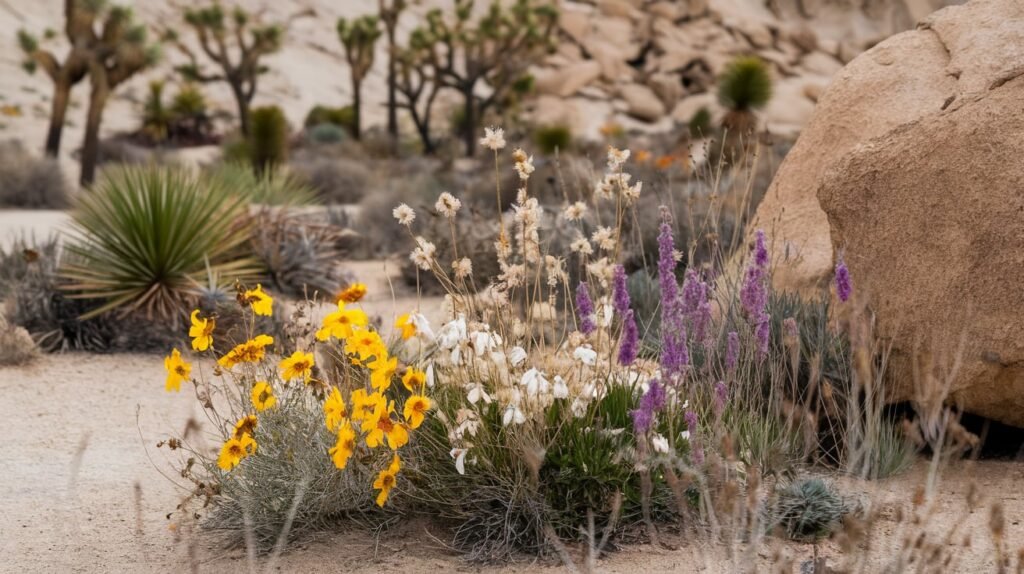Introduction
Joshua Tree National Park, renowned for its striking landscapes and diverse flora, is a haven for wildflower enthusiasts. The “wildflowers of Joshua Tree country Salicaceae” hold a special allure among the myriad plant families gracing this arid land. Known for their resilience and beauty, these wildflowers thrive in the challenging desert environment, adding vibrant splashes of color to the rugged terrain.
The Salicaceae Family: An Overview
The Salicaceae family, commonly called the willow family, is a diverse group of flowering plants that include willows, poplars, and aspens. The “wildflowers of Joshua Tree country Salicaceae” represent a unique subset of this family, adapted to the specific conditions of the desert ecosystem. These plants are visually striking and play an essential role in the park’s ecological balance.
Unique Features of the Wildflowers of Joshua Tree Country Salicaceae
The “wildflowers of Joshua Tree country Salicaceae” are characterized by their delicate blossoms, which range in color from soft whites to vibrant yellows. These flowers are adapted to thrive in the harsh desert climate, with features such as deep root systems and drought-resistant foliage. Their ability to bloom even in arid conditions makes them a symbol of resilience and beauty.
Ecological Importance of Salicaceae Wildflowers
The “wildflowers of Joshua Tree country Salicaceae” contribute significantly to the park’s ecosystem. They provide essential resources such as nectar and pollen for pollinators like bees and butterflies. Additionally, their presence helps stabilize the soil and prevent erosion, ensuring the preservation of the fragile desert landscape.
Habitat of the Wildflowers of Joshua Tree Country Salicaceae
The “wildflowers of Joshua Tree country Salicaceae” are typically found in areas with intermittent water sources, such as dry streambeds or the edges of desert oases. These habitats provide the necessary conditions for these plants to thrive, including periodic access to moisture and protection from extreme desert winds.
Seasonal Blooming of Salicaceae Wildflowers
One of the most enchanting aspects of the “wildflowers of Joshua Tree country Salicaceae” is their seasonal blooming. These flowers typically appear in late winter or early spring, depending on rainfall patterns. Their vibrant blossoms are a welcome sight for visitors, signaling the renewal of life in the desert.
The Role of Climate in Salicaceae Growth
The survival of the “wildflowers of Joshua Tree country Salicaceae” is closely tied to the region’s climate. The combination of low annual rainfall and high temperatures poses challenges, but these plants have evolved to withstand such conditions. Their adaptations include the ability to store water and endure prolonged periods of drought.
Cultural Significance of Wildflowers in Joshua Tree Country
The “wildflowers of Joshua Tree country Salicaceae” have long been celebrated by the local communities and indigenous tribes of the region. These flowers hold cultural and spiritual significance, often symbolizing renewal and the enduring beauty of nature. They are also featured in art, photography, and literature that seek to capture the essence of Joshua Tree’s unique landscape.
Conservation Efforts for Salicaceae Wildflowers
Preserving the “wildflowers of Joshua Tree country Salicaceae” is crucial for maintaining the park’s biodiversity. Conservation efforts include monitoring the impacts of climate change, reducing human disturbance, and protecting natural water sources. These initiatives aim to ensure that future generations can continue enjoying these remarkable plants’ beauty.
Photographing the Wildflowers of Joshua Tree Country Salicaceae
The “wildflowers of Joshua Tree country Salicaceae” are a favorite subject for photographers seeking to capture the desert’s ephemeral beauty. Their vibrant colors and intricate structures make them stand out against the stark desert backdrop, creating striking compositions that highlight the interplay between life and landscape.
Scientific Research on Salicaceae in Joshua Tree
Scientific studies on the “wildflowers of Joshua Tree country Salicaceae” provide valuable insights into their ecological roles and adaptive strategies. Researchers are particularly interested in understanding how these plants cope with extreme environmental conditions, as well as their interactions with other species in the desert ecosystem.
Wildflower Walks and Tours in Joshua Tree Country
Visitors to Joshua Tree National Park can experience the “wildflowers of Joshua Tree country Salicaceae” through guided tours and nature walks. These excursions offer an opportunity to learn about the region’s unique flora, including the fascinating adaptations and ecological roles of Salicaceae wildflowers.
The Aesthetic Appeal of Salicaceae Wildflowers
The “wildflowers of Joshua Tree country Salicaceae” are celebrated for their aesthetic appeal. Their delicate blossoms contrast the rugged desert landscape, creating scenes of unparalleled natural beauty. These flowers remind us of the hidden wonders that can be found in even the harshest environments.
Threats to the Wildflowers of Joshua Tree Country Salicaceae
Despite their resilience, the “wildflowers of Joshua Tree country Salicaceae” face several threats, including habitat destruction, invasive species, and climate change. Addressing these challenges is essential for ensuring the long-term survival of these unique plants and the ecosystems they support.
Educating Future Generations About Salicaceae Wildflowers
Raising awareness about the “wildflowers of Joshua Tree country Salicaceae” is vital to conservation efforts. Educational programs and community initiatives aim to inspire a sense of stewardship among visitors and local residents, fostering a deeper appreciation for the region’s natural heritage.
The Role of Wildflowers in Joshua Tree’s Identity
The “wildflowers of Joshua Tree country Salicaceae” are integral to the park’s identity. Their presence enhances the visitor experience, providing a vivid reminder of the resilience and beauty of desert life. These flowers are a testament to the wonders of nature that can thrive in even the most challenging environments.
Conclusion
The “wildflowers of Joshua Tree country Salicaceae” represent beauty, resilience, and ecological importance. From their role in supporting pollinators to their cultural and aesthetic significance, these flowers are a cherished part of Joshua Tree’s natural heritage. Protecting and celebrating these wildflowers ensures their splendor will continue to inspire and captivate for generations.

